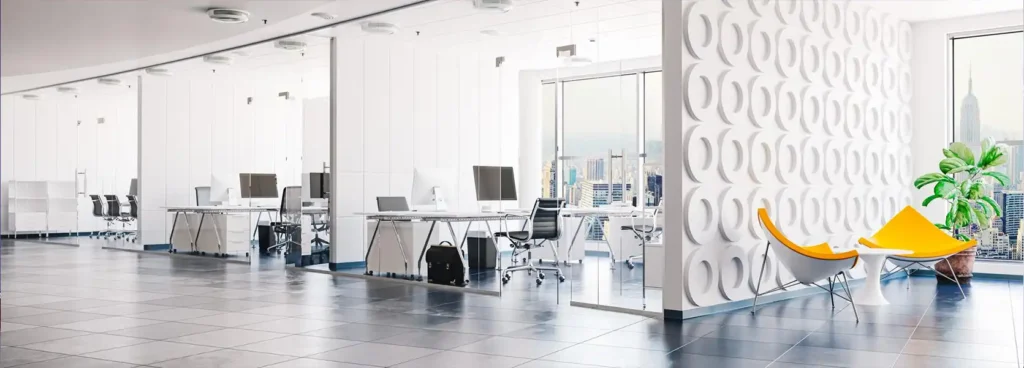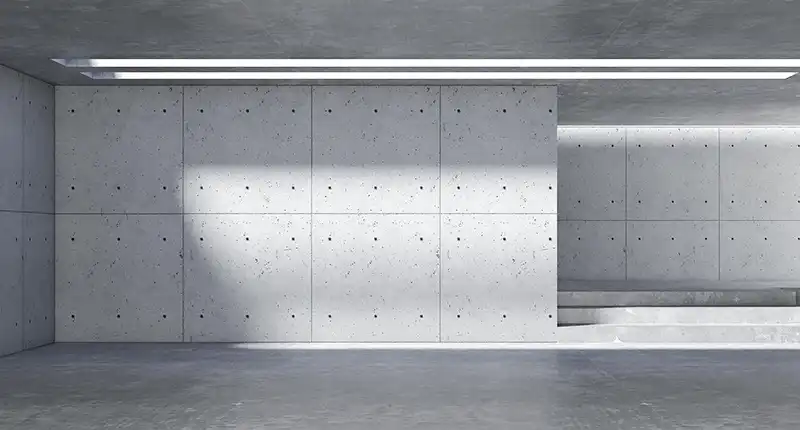
- New
- August 23, 2025
Modern Interior Design with Fiber Cement Board Panels
When architects and builders think of fiber cement board, their minds often go to its primary functions: as a durable external cladding or a reliable, water-resistant backer for tiles. For decades, it has been used for the building envelope, prized for its strength and resilience. But what happens when this functional material is brought indoors and placed in the spotlight?
A new wave of modern interior design is answering that question. In the hands of creative designers across the UAE and the world, fiber cement board is shedding its purely utilitarian reputation and emerging as a sophisticated design element. Its honest, raw texture and minimalist appeal provide a unique canvas for creating spaces that are both visually striking and incredibly practical.
Forget what you think you know about this material. Let’s explore the inspiring ways fiber cement board panels are being used to shape the future of modern interiors.
At a Glance
- 1. Unmatched Durability in a Harsh Climate
- 2. Superior Fire Resistance for Enhanced Safety
- 3. Excellent Resistance to Moisture and Humidity
- 4. Versatility in Design and Application
- 5. A Commitment to Sustainable Construction
- Conclusion: Building for a Resilient Futurem
- Building with Confidence in the UAE
- Frequently Asked Questions (FAQs)
1. The Statement Accent Wall: Raw and Refined
One of the most powerful ways to use fiber cement board indoors is to create a statement accent wall.1 In a living room, bedroom, or a grand commercial lobby, a wall of large-format panels can anchor the entire space with its subtle texture and monolithic presence. This application is perfect for achieving several popular design aesthetics:
- Industrial Loft: The raw, concrete-like appearance is the cornerstone of the industrial look. Paired with exposed ductwork, black metal fixtures, and warm leather furniture, it creates an edgy, urban vibe.
- Minimalist & Japandi: The clean lines and neutral grey tones of the board provide a serene, uncluttered backdrop. This aligns perfectly with minimalist principles and the Japanese-Scandinavian (“Japandi”) fusion style, which celebrates natural textures and simplicity.
For a high-end architectural finish, panels can be installed with expressed joints, creating a deliberate shadow gap that forms a clean grid. Alternatively, for a seamless, continuous look, the joints can be filled and skim-coated to resemble a solid, cast-concrete wall.
2. Sleek and Functional Kitchen & Bathroom Paneling
Kitchens and bathrooms are high-moisture, high-traffic environments that demand durable materials.2 While tiles have been the traditional choice, fiber cement board offers a compellingly modern alternative. Used as a full-wall paneling system, it provides a seamless, grout-free surface that is both chic and incredibly easy to clean.
Imagine a walk-in shower lined with large, smooth panels for a minimalist, spa-like retreat. Consider a sleek kitchen backsplash that runs from countertop to ceiling, creating a durable and non-combustible surface behind the hob. Because of its inherent moisture and mould resistance, fiber cement board provides not only a beautiful aesthetic but also long-term peace of mind in these critical wet areas.

3. Industrial Chic Ceilings and Soffits
Why should walls have all the fun? Applying fiber cement board to ceilings is a bold design move that can define a space from above. It’s an effective way to achieve an industrial feel in an open-plan home, a creative office, or a trendy café. It can conceal services like wiring and plumbing while still providing a finished, intentional look. The visual effect is powerful, creating a grounding plane that can be contrasted beautifully with track lighting, warm wood floors, or elegant furniture below.
4. Custom-Built Furniture and Integrated Fixtures
The true versatility of a material is proven when it can be shaped into three-dimensional forms. The strength and workability of fiber cement board allow designers to move beyond flat surfaces and create custom, integrated furniture.4 This allows for a cohesive material palette to flow through the entire space.
Think of a minimalist media unit that appears to emerge from the wall, a monolithic reception desk in an office lobby, or a waterfall-edge kitchen island wrapped entirely in fiber cement panels. When properly supported and sealed, it can become a core component of bespoke cabinetry, shelving, and architectural fixtures, offering a unique and durable alternative to wood or stone.
5. The Art of the Finish: Beyond Plain Grey
Perhaps the biggest misconception about using fiber cement board in interiors is that you are limited to a single shade of grey. The reality is that the board is a blank canvas awaiting the designer’s touch. The finishing possibilities are vast:
- Clear Sealing: For purists who love the raw, authentic cementitious look, a simple clear matte sealant protects the board while preserving its natural colour and texture.
- Painting: The smooth surface accepts paint beautifully. A high-quality acrylic paint can be used to match any colour scheme, from stark white for a minimalist gallery look to a deep charcoal for a dramatic, moody effect.
- Staining: Concrete stains can be applied to create a more varied patina, giving the panels a weathered, nuanced appearance that adds depth and character.
Polished Finishes: For a truly luxurious surface, the boards can be used as a substrate for a micro-cement or plaster skim coat, achieving the seamless, hand-troweled look of polished concrete or Tadelakt.
Conclusion: A New Chapter for a Timeless Material
Fiber cement board has earned its place as a high-performance building material. Now, it is proving its worth as a high-style design element. It offers the rare combination of a raw, authentic aesthetic with the practical, high-performance characteristics required for modern living and working.
For designers, architects, and builders in the UAE looking to push creative boundaries while specifying materials that are durable, safe, and resilient, it’s time to look beyond the facade. The future of interior design is authentic, expressive, and built to last.
Design with a Strong Foundation
The future of interior design is about using authentic, durable, and expressive materials. If you are ready to explore the creative possibilities of fiber cement panels for your next interior project, our team is here to provide the technical support and high-quality materials you need.
Contact us to learn more about our range of interior-grade fiber cement board specifications.
Frequently Asked Questions (FAQ’s)
Q: Can I hang heavy pictures, mirrors, or shelves on a fiber cement board wall?
Yes. Because fiber cement board is strong but brittle, you cannot rely on the board itself to hold a screw. You must use appropriate wall anchors designed for cement boards (like sleeve-type or expansion anchors) or, for very heavy items, locate and fix directly into the wall studs behind the board.
Q: What is the best type of paint to use for fiber cement board indoors?
A high-quality, 100% acrylic latex paint is recommended. Always start with a primer suitable for cementitious or masonry surfaces to ensure proper adhesion and a uniform final coat.
Q: How do you clean interior fiber cement panels?
For general cleaning, a soft, damp cloth is usually sufficient. For more stubborn marks, a mild solution of soap and water can be used. Avoid abrasive cleaners or harsh chemicals that could damage the paint or sealant.
Q: Is fiber cement board a sustainable choice for interiors?
Yes, it is considered a sustainable option due to its exceptional durability and long lifespan, which reduces the need for replacement.5 It is also inert and non-toxic, contributing to good indoor air quality.
At a Glance
- 1. The Statement Accent Wall: Raw and Refined
- 2. Sleek and Functional Kitchen & Bathroom Paneling
- 3. Industrial Chic Ceilings and Soffits
- 4. Custom-Built Furniture and Integrated Fixtures
- 5. The Art of the Finish: Beyond Plain Grey
- Conclusion: A New Chapter for a Timeless Material
- Frequently Asked Questions (FAQ's)